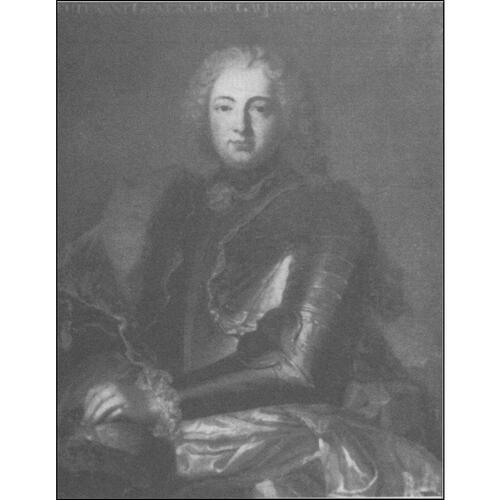LA ROCHEFOUCAULD DE ROYE, JEAN-BAPTISTE-LOUIS-FRÉDÉRIC DE, Marquis de ROUCY, Duc d’ANVILLE, naval officer; b. 17 Aug. 1709, son of Louis de La Rochefoucauld, Marquis de Roye, lieutenant-general of the galleys, and Marthe Ducasse; m. 28 Feb. 1732 Marie-Louise-Nicole de La Rochefoucauld, by whom he had a son and two daughters; d. 27 Sept. 1746 at Chebucto (Halifax, N.S.), and buried on George Island in the port of Halifax, then at Louisbourg, Île Royale (Cape Breton Island), and finally in France.
Jean-Baptiste-Louis-Frédéric de La Rochefoucauld de Roye was invested on 7 Dec. 1720 with the reversion of the office held by his father, but as his father did not die until 1751, he never actually held it. He was made Duc d’Anville by letters patent from the king on 15 Feb. 1732. In 1734 he was serving on board a galley, but because the corps of officers for service on the galleys was about to be abolished, d’Anville was transferred to the sailing-ship component of the Marine, retaining his rank. In January 1745 he was appointed lieutenant general of naval forces. He does not seem ever to have received proper naval training, and he was in no way qualified to lead the expedition which he commanded the following year.
After Louisbourg fell to William Pepperrell and Peter Warren in June 1745, the Duc d’Anville was given the mission of trying to retake the citadel, defend Canada against a possible English attack, and undertake operations as far as possible against the English settlements in Acadia and Newfoundland. To carry out this ambitious program, a squadron of 54 ships had been planned; d’Anville was supported by the rear-admirals La Jonquière [Taffanel] and Constantin-Louis d’Estourmel. The fitting-out of this fleet was slow and difficult, and it did not set sail until 22 June 1746. Wind-bound, the squadron did not sight the coasts of Acadia until 10 September. Three days later it was scattered by a violent gale that seriously damaged some ships, which were consequently forced to return to France. D’Estourmel entered Chebucto harbour on 27 September, only to learn that d’Anville had died at three o’clock that morning “of an attack of apoplexy, which had seized him on the morning of the 25th while walking on his forecastle deck.” D’Estourmel then took command, but on 30 September he wounded himself seriously while trying to commit suicide and handed his powers over to La Jonquière. The sorry state of the squadron, with its ships battered by the elements, and their crews reduced by an epidemic, led La Jonquière to give up any attack on Annapolis Royal, Nova Scotia. A return of losses as of 15 October listed 587 dead and 2,274 sick out of a total complement of 7,006 sailors and soldiers. Four transport ships left for Canada on 10 October, escorted by the Renommée under the command of Guy-François de Coëtnempren de Kersaint; the others set sail for France two weeks later.
The expedition was a complete failure, which can be explained by several factors, bad luck being not the least important. The failure emphasized forcefully the weakness of the French navy and also the difficulties of assisting the French colonies in North America. These were the logical consequences of the neglect of the French navy since the death of Louis XlV: the ships were insufficient in number, and, since they had done little sailing for years, the officers as well as the crews were inadequately trained.
AN, Marine, B2, 328; B4, 59; C1, 161. La Chesnaye-Desbois et Badier, Dictionnaire de la noblesse (3e éd.), VII, 336. Lacour-Gayet, La marine militaire sous Louis XV (1910), 177, 194–96, 200–2. Troude, Batailles navales de la France, I, 309.
Cite This Article
Étienne Taillemite, “LA ROCHEFOUCAULD DE ROYE, JEAN-BAPTISTE-LOUIS-FRÉDÉRIC DE, Marquis de ROUCY, Duc d’ANVILLE,” in Dictionary of Canadian Biography, vol. 3, University of Toronto/Université Laval, 2003–, accessed January 19, 2026, https://www.biographi.ca/en/bio/la_rochefoucauld_de_roye_jean_baptiste_louis_frederic_de_3E.html.
The citation above shows the format for footnotes and endnotes according to the Chicago manual of style (16th edition). Information to be used in other citation formats:
| Permalink: | https://www.biographi.ca/en/bio/la_rochefoucauld_de_roye_jean_baptiste_louis_frederic_de_3E.html |
| Author of Article: | Étienne Taillemite |
| Title of Article: | LA ROCHEFOUCAULD DE ROYE, JEAN-BAPTISTE-LOUIS-FRÉDÉRIC DE, Marquis de ROUCY, Duc d’ANVILLE |
| Publication Name: | Dictionary of Canadian Biography, vol. 3 |
| Publisher: | University of Toronto/Université Laval |
| Year of publication: | 1974 |
| Year of revision: | 1974 |
| Access Date: | January 19, 2026 |



